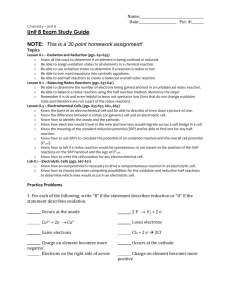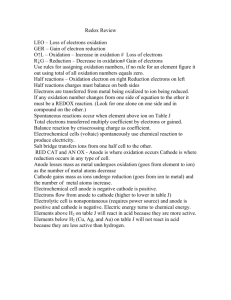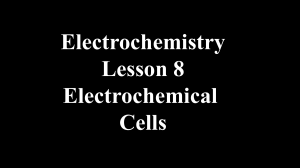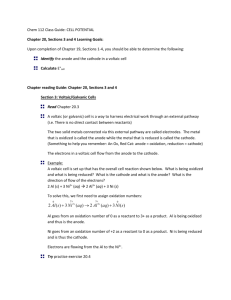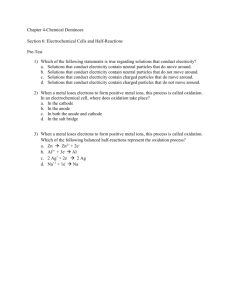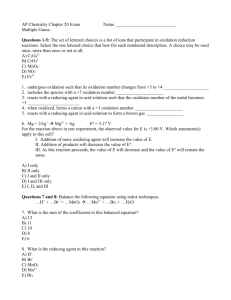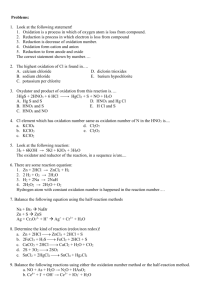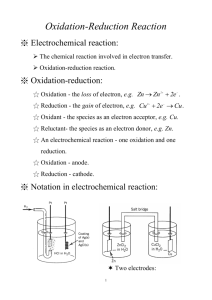Unit 8: Redox & Electrochemistry
advertisement
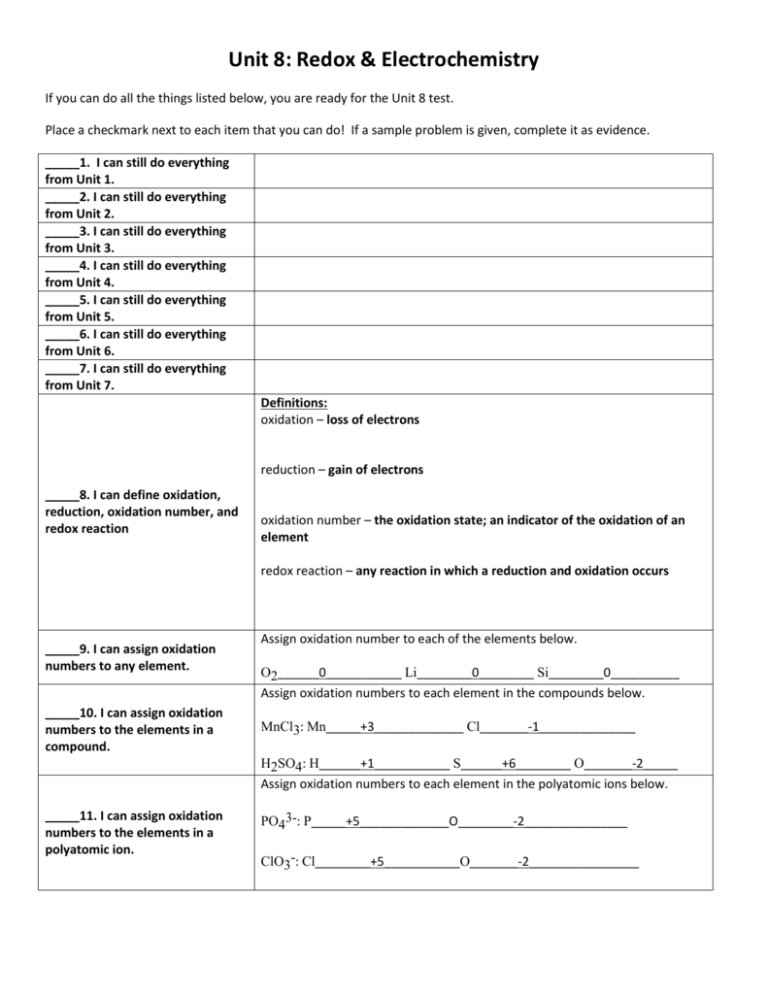
Unit 8: Redox & Electrochemistry If you can do all the things listed below, you are ready for the Unit 8 test. Place a checkmark next to each item that you can do! If a sample problem is given, complete it as evidence. _____1. I can still do everything from Unit 1. _____2. I can still do everything from Unit 2. _____3. I can still do everything from Unit 3. _____4. I can still do everything from Unit 4. _____5. I can still do everything from Unit 5. _____6. I can still do everything from Unit 6. _____7. I can still do everything from Unit 7. Definitions: oxidation – loss of electrons reduction – gain of electrons _____8. I can define oxidation, reduction, oxidation number, and redox reaction oxidation number – the oxidation state; an indicator of the oxidation of an element redox reaction – any reaction in which a reduction and oxidation occurs _____9. I can assign oxidation numbers to any element. _____10. I can assign oxidation numbers to the elements in a compound. Assign oxidation number to each of the elements below. O2______0___________ Li________0________ Si________0__________ Assign oxidation numbers to each element in the compounds below. MnCl3: Mn_____+3_____________ Cl_______-1______________ H2SO4: H______+1___________ S______+6________ O_______-2_____ Assign oxidation numbers to each element in the polyatomic ions below. _____11. I can assign oxidation numbers to the elements in a polyatomic ion. PO43-: P_____+5_____________O________-2_______________ ClO3-: Cl________+5___________O_______-2________________ Which half-reaction equation represents the reduction of a potassium ion? A) K+ + e- -----> K B) K + e- -----> K+ C) K+ -----> K + eD) K -----> K+ + e- _____12. I can distinguish between an oxidation half-reaction and a reduction half-reaction. _____13. I can state the Law of Conservation of Charge. The law of Conservation of Charge states in any chemical reaction charge must be conserved The two half-reactions that come from the following equation are: Li(s) + Ag+(aq) -----> Li+(aq) + Ag(s) oxidation half-reaction _____14. I can break a redox reaction into its two half-reactions. Li(s) -----> Li+(aq) + e- reduction half-reaction Ag+(aq) + e- -----> Ag Given the reaction: _____Cl2(g) + _____Fe2+(aq) -----> _____Fe(s) + _____Cl-(aq) When the equation is correctly balanced using smallest whole numbers, the coefficient of Cl- will be A) 1 B) 2 C) 6 D) 7 _____15. I can balance a redox reaction. _____16. I can identify a redox reaction from a list of chemical reactions. Which of the following elements is most likely to react? _____17. From a list of given list of elements, I can determine which element is most active. A) Cu B) Al C) Li D) Mg The two types of electrochemical cells are: _____18. I can state the two types of electrochemical cells. ___voltaic_____ and ______electrolytic_________ Voltaic salt bridge anode cathode electrolyte power supply anode cathode electrolyte Oxidation occurs at the anode anode Reduction occurs at the Electrons flow from cathode cathode anode to cathode anode to cathode Energy conversion that occurs in this cell chemical energy is converted to electrical energy electrical energy is converted to chemical energy Is this reaction spontaneous or does it require an outside power source to happen? spontaneous requires and outside power source Components _____19. I can compare the two types of electrochemical cells in terms of: components, location of oxidation, location of reduction, direction of electron flow, conversion between electrical and chemical energy, and spontaneity of reaction. Electrolytic The purpose of the salt bridge is to allow for the migration/movement of ions _____20. I can state the purpose of the salt bridge in a voltaic cell. _____21. Given an electrochemical cell, I can predict the direction of electron flow. _____22. I can explain, in terms of atoms and ions, the changes in mass that take place at the anode and cathode of an electrochemical cell. Explain, in terms of atoms and ions, why the mass of the cathode increases during the operation of an electrochemical cell. The mass of the cathode increases because ions from the solution get reduced to atoms and become part of the cathode. Explain, in terms of atoms and ions, why the mass of the anode decreases during the operation of an electrochemical cell. The mass of the anode decreases because atoms from the cathode get oxidized into ions and become part of the solution.

